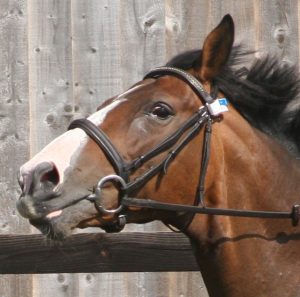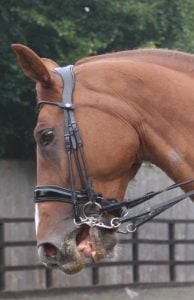There are two things that riders should think twice about saying, writes CAROLYN HENDERSON.
One is “My horse is being naughty” and the other is “My horse always goes like that.” You may disagree, and you may phrase the first observation in stronger terms. But before you’re tempted to think that your horse is refusing to canter on the left lead because he wants to wind you up, or fidgets when you want to mount because he feels like behaving badly, look at some brilliant research from one of the UK’s top equine vets.
Signs of pain include wide eyes, ear position, and head twisting.
Dr Sue Dyson, the Animal Health Trust’s head of clinical orthopaedics, has developed an ethogram to help identify changes in a ridden horse’s facial expression. These changes can help identify signs of pain – and may help some people discover that their “naughty” horse is, in fact, lame.
While most people should be able to spot obvious lameness, low grade problems can challenge all but specialist vets. If a horse is 1/10 or 2/10 lame, a rider may put it down to reluctance to go forward or insist that a horse is “bridle lame” – and that’s another term to argue about.
As Dr Dyson points out, if pain-related problems are dismissed as behavioural glitches, a horse will continue in work and the problem will get progressively worse. His owner may not seek veterinary advice until months down the line, when treatment may be more difficult, more expensive and have less chance of success. What she’s found out is that lay people – and even some vets - find it easier to identify changes in a horse’s facial expression and head position than to spot subtle lameness.
Her ethogram is a catalogue of facial expressions including the ears, eyes, nose, muzzle, mouth and head position – not to be confused with a hypothesis that facial characteristics can be used to categorise horses as right or left-brained introverts or extroverts
This horse had a pain score of 3 for its mouth.
In its first stage of testing, the ethogram was applied successfully by people from different backgrounds, who studied photographs of horses’ heads while they were ridden. In the second stage, the ethogram was used to distinguish between sound and lame horses.
During this phase, a pain score from 0 - 3 was applied to each of the facial expressions, then totalled to determine an overall pain score for each horse. Dr Dyson used 519 photos of horses and ponies, ranging from children’s ponies to advanced competition horses, which she had categorised as lame or sound.
A total of 27,407 facial markers was recorded, with results showing that there was a scientifically significant difference in pain scores given by the assessor for clinically lame and sound horses. The fact that a horse lays back his ears when another invades his space doesn’t, of course, mean that he is lame. But by focusing on this range of expressions, Dr Dyson has proved that the ethogram is a clear indicator of pain which owners, riders and trainers could apply.
Even more exciting, she and her team are working on a “whole horse” ethogram that could give even clearer indications that a horse is in pain. What better way to help us face up to our responsibilities as owners? If you'd like to find out more, watch this video of Dr Sue Dyson discussing the research.



